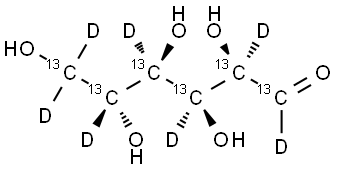Uses
Labelled D-Glucose is a simple sugar that is present in plants. A monosaccharide that may exist in open chain or cyclic conformation if in solution. It plays a vital role in photosynthesis and fuels the energy required for cellular respiration. D-Glucose is used in various metabolic processes including enzymic synthesis of cyclohexyl-α and β-D-glucosides. Can also be used as a diagnostic tool in detection of type 2 diabetes mellitus and potentially Huntington''s disease through analysis of blood-glucose in type 1 diabetes mellitus.
Uses
Labelled D-Glucose. Used in enzymic synthesis of cyclohexyl-α and β-D-glucosides
Uses
D-GLUCOSE-13C6-1 2 3 4 5 6 6-D7 99 ATO& is a simple sugar that is present in plants. A monosaccharide that may exist in open chain or cyclic conformation if in solution. It plays a vital role in photosynthesis and fuels the energy required for cellular respiration. D-GLUCOSE-13C6-1 2 3 4 5 6 6-D7 99 ATO& is used in various metabolic processes including enzymic synthesis of cyclohexyl-α and β-D-glucosides. Can also be used as a diagnostic tool in detection of type 2 diabetes mellitus and potentially Huntington's disease through analysis of blood-glucose in type 1 diabetes mellitus.
General Description
D- Glucose is a monosaccharide (simple sugar). It is a vital source of energy for living organisms. It exists in a cyclic form, containing six carbon atoms. It is present naturally in all plants and fruits in free or bound state. It is synthesized by the process, gluconeogenesis, in the liver and kidney.
Biochem/physiol Actions
D-Glucose is involved in the metabolic processes, such as glycolysis and Kreb′s cycle for the generation of adenosine triphosphates. It is stored in the form of glycogen in liver. D-Glucose moieties constitutes to form cellulose by β-1,4-glycosidic linkage.
